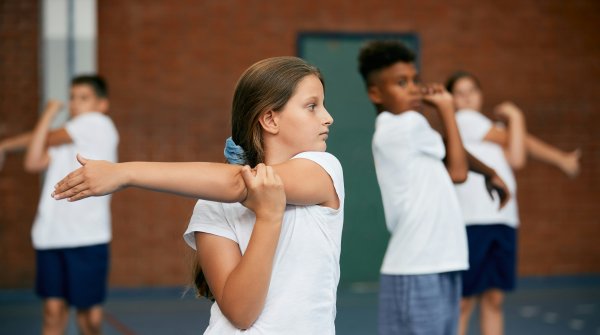
At age twelve, Janine weights 80 kilos; at age 14 she resembles Obelix: at 172 centimeters tall the scale shows her weight at 120 kilos. Every day, she stuffs herself with pizza, ice cream, chips, toast and chocolate, chased with liters of soft drinks. During the night, she sneaks into the kitchen and eats half of the week’s groceries stored in the fridge.
“I spend my days playing computer games. After dinner I sit in front of the computer and play until I get tired. Then I’ll go to bed. I’ve never played any sports, I’ve always just gained weight.” The teenager’s body mass index (BMI) is 40. At her height a normal BMI would be half of that, which corresponds to a weight of 60 kilos. If Janine does not radically change her lifestyle and loses weight, she will reduce her life expectancy by ten to twenty years.
No longer just a problem in the USA
Excessive weight and adiposis (obesity) in children and youths is no longer just a problem in the USA, the home of fast food and “super size me” meals, even though the highest number of obese children and teens still live there. The World Health Organization (WHO) already calls it the “global epidemic of the 21st century”.
According to statements by the Organization for Economic Cooperation and Development (OECD) every third child in its member states has too much fat on their hips. The percentage of obese girls in Germany alone has doubled within as few as five years, according to the OECD. Over 40 percent of the excessively overweight are under 18 years old.
Waists are disappearing and belly girths are increasing from Istanbul to Mexico City. In Venezuela, 65 percent of children over 15 years old fight against excessive weight, every fourth is obese. The WHO states the particularly alarming fact that more and more children are becoming obese. In China, the number of overweight children and youths has also increased rapidly.
Health and Nutrition Organization is warning
According to a report published in 2010 by the Public Health and Nutrition Organization their number tripled between 1982 and 2002 – and the problem has become even bigger in the last few years. The one-child policy misled many parents to spoil and positively stuff their children.
A well-fed child is often still considered a sign of health and prosperity. Excessive weight has become almost a plague. The economic boom has changed the nutritional habits of many Chinese; they now prefer French fries to their traditional rice, and eat more meat instead of vegetables.
Developing nations are concerned
A phenomenon also observed in other emerging and developing nations – affluence has opened the doors to unhealthy western lifestyles. Instead of cooking from scratch, pre-made meals are heated in the microwave; and for in between there are sweet “kiddie” yogurts and calorie-rich snacks. Fruits and vegetables? No way.
Many children don’t even know what kind of fruit or veggies there are, or even how they taste. Research shows that the number of overweight and obese teenagers increases with a decreasing level of education and income of their parents.
Parents who constantly suck down cola for refreshment and eat inches-thick chocolate spread on their toast are not exactly positive role models.
Excessive weight is dangerous
Experts agree: excessive weight is dangerous; the increasing number of overweight children and teenagers is a reason to be very concerned about the future. Fact is that people who are overweight during their childhood will often stay heavy for the rest of their lives, and will likely become frequent visitors to their doctor’s office as an adult.
Obese 16-year-olds already suffer from diseases usually seen only in 60-year-olds. They have to deal with diabetes, cardiovascular diseases, kidney and liver problems, as well as joint damage. In addition to eating unhealthy foods the primary reason for excessive weight is a lack of physical activity.
According to a study by the International Council of Sport Science and Physical (ICSSPE) this is the first time that this lack of exercise can decrease the life expectancy of children by five years compared to their parents’. The ICSSPE estimates that in China and India alone the consequential costs caused by lack of physical activity will increase by 450 percent by 2030.
The ratio of couch potatoes increases
The results of a WHO study on the health habits of school children in 40 countries and regions of Europe and North America are also cause for concern. It shows that more than 80 percent of Germany youths, for example, do not exercise enough.
The ratio of couch potatoes increases in particular between the age of 11 and 15: while every fourth 11-year-old boy and every fifth girl have enough activity, the ratio of 15-year-old boys decreases to only 13.6 percent, and 8.6 percent in girls of the same age.
In a Europe-wide comparison, Germany is among the last on the list. A total of 85 percent of 15-year-olds are couch potatoes, according to the WHO results.
Exercise 60 minutes per day
“International recommendations state that young people should exercise at least 60 minutes during every day, at a rate that increases their heart rate and makes them sweat,” says Jens Bucksch, healthcare expert at the Bielefeld University, where the German part of the study was coordinated.
“Unfortunately, most youngsters do not even satisfy this minimum. While the exercise habits of young people have not really decreased any further in the last ten years, they have leveled off at a very low plateau.”
Differences between the sexes
The differences between the sexes are striking. Girls have worse statistics than boys in all countries. The negative record is held by young Italian females: at age eleven seven percent cover the recommended sixty minutes of physical activity; only five percent at ages 13 and 15.
Why girls are less motivated to become active researchers have not yet analyzed. “It is likely that girls and boys have other motives and preferences when it comes to physical activity,” Bucksch speculates.
“It seems that their interests may change even more radically when girls reach puberty. Due to their changing bodies, because they might not be happy with their appearance or do not want to show themselves to others, they might reject exercise and sports more. In addition, girls often receive less incentive to play sports than boys.”
It is hazardous to their health
The researchers from Bielefeld also evaluated the varying levels of sports between the genders: at least 38 percent of German boys stated they spend four hours or more playing sports every week, the percentage of girls was only at 25 percent.
“The data is not very representative, we need more comprehensive studies,” demands the Director of the Institute for Sports Medicine at the University of Münster, Klaus Völker. Völker and his team evaluated 1,500 students in the Münster region for his project “Alltags-Aktivitäts-Studie” (Everyday Activity Study), and also observed that the activity of the students continuously decreased from first grade to graduating class. In the higher grades students only exercised at a “level so low it is hazardous to their health.
Twenty minutes of sports per week is not nearly enough
They often don’t realize how little they move,” Völker warns. “The results of self-assessment questionnaires do not match at all with the actually measured data.” Even physical education at schools cannot make up for it. “A well-organized class has about 20 minutes of activity, everything else is used to organize the activity.
If students are lucky, they get two times twenty minutes of sports per week, and that is not nearly enough.” Finally: according to a study by the Free University of Berlin, a student has an average of seven minute of actual activity during a physical education class, or twelve minutes during a double-length class.
10,000 paces are the standard for healthy life
10,000 paces per day are the standard for a healthy life. Medical professionals all agree on this number. Under 5,000 steps is considered a sedentary lifestyle, between 5,000 and 7,500 is considered moderate activity, and over 10,000 paces per day is considered active. Völker: “During childhood we make 7,000 to 8,000 steps, when puberty starts the number might reach 6,000, and falling thereafter.”
Elementary students spend nine hours a day lying down, nine hours sitting, and maybe five hours on their feet, according to research by the Bertelsmann Foundation and the University of Karlsruhe. During this time they might have all of 15 to 30 minutes of vigorous activity – not more. Instead of romping around outside or go out and meet friends in the neighborhood as a teenager, many of them stay glued to the television or computer and don’t move from the couch or chair.
Parents are to blame for their children’s couch potato habits
Instead of riding a bike or walking, mom or dad drives them to school or they take a bus or subway. “Today, distances are no longer covered on foot, the car is more convenient. Our environment has changed radically and offers little motivation for physical activity. School yards, for example, are no longer designed as open spaces,” Bucksch complains.
More often than not parents are to blame for their children’s couch potato habits. Many don’t allow their kids to roam the city streets, worried that something might happen to them. Are there still places for children? Are they still part of the urban scene? Is an 11-year-old allowed to run around the streets for an hour between the end of school and a music lesson?
It is clear that young people who have too little physical activity while growing up will very likely also continue this lifestyle as adults – complete with all the negative consequences.
- ISPO awards
- Mountain sports
- Bike
- Design
- Retail
- Fitness
- Health
- ISPO Job Market
- ISPO Munich
- ISPO Shanghai
- Running
- Brands
- Sustainability
- Olympia
- OutDoor
- Promotion
- Sports Business
- ISPO Textrends
- Triathlon
- Water sports
- Winter sports
- eSports
- SportsTech
- OutDoor by ISPO
- Heroes
- Transformation
- Sport Fashion
- Urban Culture
- Challenges of a CEO
- Trade fairs
- Sports
- Find the Balance
- Product reviews
- Newsletter Exclusive Area
- Magazine






